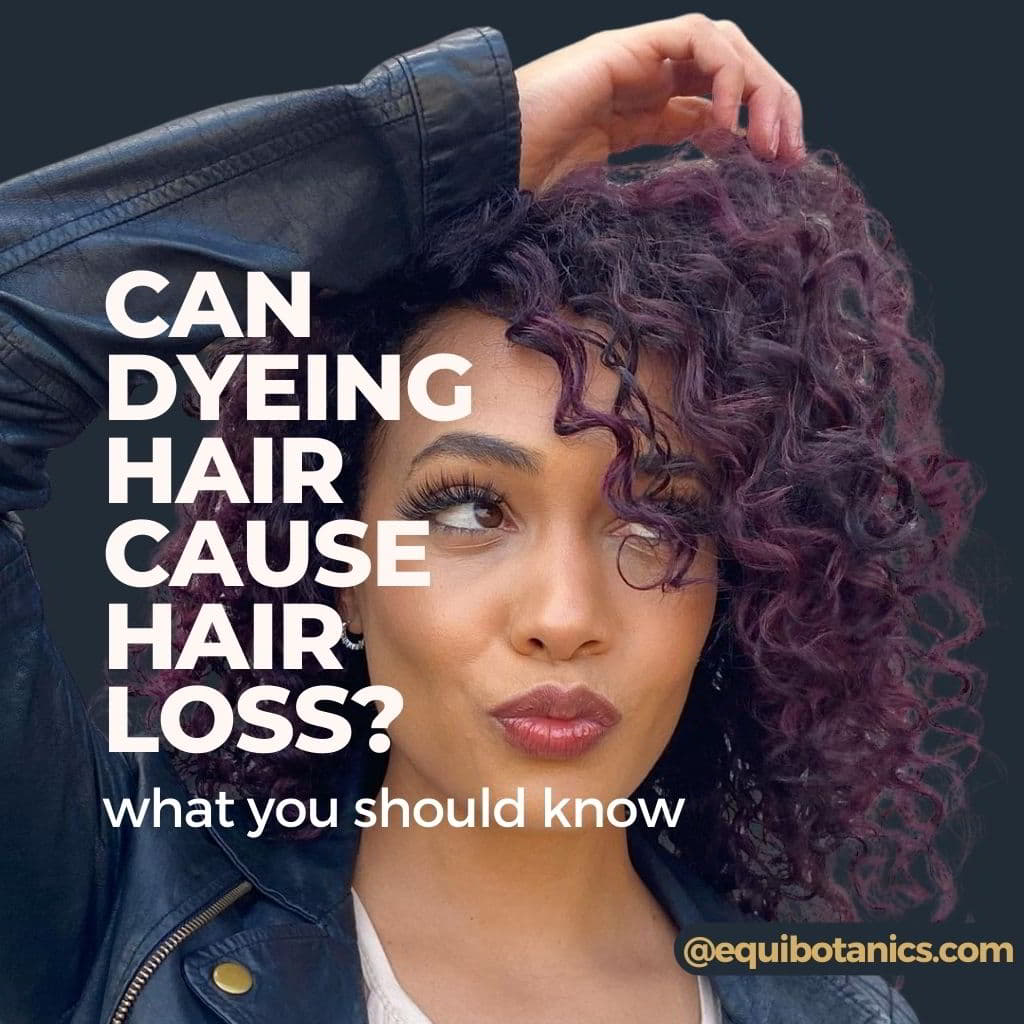
Switching up hair colours is an age-old popular way of changing your look in just a few hours of sitting in a salon chair.
It is common knowledge that the chemical process of dyeing hair can be damaging to locks causing dryness, but dyeing hair can also cause hair loss. If you’ve noticed more strands of your coloured hair shredding recently, your salon trips could be behind it.
Don’t panic though! Hair loss from hair dye can grow back and we’re here to tell you all you need to know including natural alternatives to hair dye, preventing further loss, and even how to regrow it!
Key Takeaways
- Hair dye chemicals such as PPD, ammonia, and hydrogen peroxide, are damaging to hair and trigger loss
- The best preventative measure is to refrain from colouring hair, although you could use natural alternatives such as lemon juice or black seed oil
- When suffering with severe hair loss, consult a doctor who may prescribe minoxidil.
Can hair dye cause hair loss?

Ultimately, dyeing hair does cause hair loss. There are several reasons for hair dye causing hair loss, including the harsh chemical ingredients in dyes and the excessive combing, rubbing, and manipulation of hair.
Chemical ingredients including hydrogen peroxide and ammonia within some hair dyes are known to damage hair and scalp health as they break through the defensive layer of the hair strands. The chemical components in the dye damage the protein within the hair shaft to weaken it, as well as snap locks, particularly those in the telogen stage of the hair cycle.
Ultimately, every time you colour your hair, there is an increased risk of hair loss. Whilst hair dye does not slow or prevent growth, the damage it causes can lead to hair loss and damage, particularly to new hair growth. Dyeing can also be bad for hair that is already thinning, as it is already in a weakened state.
The good news is that hair loss due to hair dye can grow back with specific treatments, but it will take time.
What type of hair loss is caused by hair dye?
The type of hair loss that is caused by dyeing hair is known as telogen effluvium, which sees hair shed more frequently, causing an overall thinning due to the disturbance to the hair cycle.
Scientific studies have shown that telogen effluvium can occur in those who have allergic reactions to hair dyes containing paraphenylenediamine, more commonly known as PPD, because the ‘contact dermatitis’ caused by the reaction will trigger hair loss.
Other common ingredients that can cause telogen effluvium include hydrogen peroxide and ammonia which can both loosen hair strands during the telogen phase of the cycle.
Are certain dyes worse?

Some chemicals in hair dyes are worse than others at causing hair loss. The main chemical culprits that cause hair to fall include:
1. Paraphenylenediamine
PPD is used as a dye for darker shades. It is derived from petroleum and is also used as a wood preservative. When combined with hydrogen peroxide, it is particularly toxic. In recent years it has gained notoriety due to some well publicised, severe allergic reactions.
2. Hydrogen Peroxide
This chemical is used to oxidise melanin in your hair, which is what gives tresses their natural colour. It changes hair structure, making it brittle and lacklustre.
3. Ammonia
This is used to lift the PH level of hair whilst being coloured. It opens up cuticles so it can enter the hair and deposit colour. Ammonia is damaging as it destroys the hair’s natural proteins as well as depletes moisture.
4. Resorcinol
Reacting with the developer, resorcinol helps to permanently bond colour to the hair but it also causes scalp irritation.
How to stop hair fall and regrow after colouring
1. Avoid permanent hair dyes
Semi-permanent hair dyes tend to have more gentle formulations compared to permanent dyes, as they don’t contain alcohol or ammonia.
If you wish to continue colouring your hair, switching to a semi-permanent solution would be better and leaving at least six weeks between each treatment. This can limit hair and scalp damage. Although it won’t necessarily eliminate hair loss, you are likely to see a reduction in the volume of hair fall.
2. Use natural dyeing methods
There are several natural methods that you can use to alter the colour of your hair, these include:
Lemon Juice
Bleaching hair can also lead to hair falling out, but you can lighten your hair naturally without chemicals using lemon juice and some sunshine. Mix the juice of a lemon with water in a spray bottle, spritz liberally over hair paying particular attention to the roots, leaving to air dry in the sun.
Natural Box Dyes
Natural hair dye formulations are much gentler to your hair. They use ingredients such as cassia powder, henna powder, and indigo leaf powder to alter hair colour.
Black Seed Oil
Often referred to as a miracle oil, black seed oil can encourage pigment cells and stimulate melanin production to naturally darken hair. Not only can it work to re-colour greys, but using a product such as the Black Seed Hair Oil Elixir can also help to promote regrowth.
Black Seed Hair Oil Elixir
This Black Seed Oil For Hair is enriched with Fenugreek, Brahmi and Bhringaraj ayurvedic oils, our first hair serum is your best bet to reaching your hair goals. Stop split ends, check. Stop itchy scalp, check. Help accelerate growth, check check check. We've jam-packed this little bottle with luxurious ingredients from the Caribbean, India and the Amazonian rainforest to give you longer, thicker, and stronger hair in less time.
3. Eat a balanced diet
If you are looking to regrow hair that has fallen out or thinned, look at changing your diet.
Incorporate more of vitamins A, B, C and D as well as nutrients such as iron and zinc into what you eat. These are all vitally important to hair health, as well as helping with regrowth.
Food sources that are good for locks include red meat, spinach, lentils, oily fish, chia seeds, walnuts, and berries. If you are vegan, you could consider using nutritional yeast in pasta dishes to increase growth rate and restore brittle locks.
4. Use a hair mask
Restore damaged locks to their former glory with regular use of a hair mask, such as the Babassu Oil Treatment Hair Masque. Nourishing formulations found in hair masks improve hair and scalp health, strengthening strands to help prevent further breakages, as well as gently repairing damaged tresses.
Babassu Oil Treatment Hair Masque
The Babassu Deep Treatment Hair Masque is an intensive protein-moisture balanced treatment that applies a restorative formula to the hair, using steam to encourage absorption into the hair shaft. It is jam-packed with Brazilian butter, Tucuma and Murumuru seed butters and revitalising oils to nourish your hair. It’s so rich and gets to work for longer, you only need to apply it once or twice a month.
5. Avoid heat styling
Using heat can damage hair at the best of times, but it’s especially important to reduce exposure to heat when locks are chemically damaged and falling out. Where possible, allow hair to air dry but when you do need to style it, reduce the heat setting and apply a protectant spray.
6. Medication
If your hair loss is severe or persistent, you could consider seeking medical advice. Upon consultation with a doctor, you may be prescribed minoxidil. This works to stimulate hair growth by reversing shrinking hair follicles, encouraging blood flow, pushing follicles into a growth phase, and extending the time each follicle stays within this phase.
What else could be causing hair loss?

Although hair dye can be a cause of hair loss, it may not be behind your shedding locks. It is worth considering other factors in your life that may be causing your thinning locks, including:
1. Stress
Stress and anxiety are all too common amongst us these days, but not only is it mentally damaging, it can also have an impact on your body, including your locks.
2. Medication or illness
Certain medications and conditions can cause hair loss. For example, chemotherapy treatment, but also undergoing surgery, such as a hysterectomy.
3. Hair styles and extensions
Not only does hair colouring cause hair loss, but some hair styles, such as tight ponytails and the use of extensions can too. The tension created from these styles can cause traction alopecia, which is typically displayed by patches where strain has been felt.
4. Hormones
Childbirth, post-pregnancy, and the menopause can all cause hair loss and thinning due to hormonal imbalances.
5. Diet
A poor diet can mean that your vitamin and nutrient intake is compromised, which impacts the health and condition of your hair as well as affecting hair growth.
6. Harsh products
Just like hair dyes, there are many hair care products that contain harsh chemicals. Switch to naturally derived formulations, as found our Standard Package. Natural hair products are free from sulphates and other nasties that could be stripping hair of natural oils, making it dry and brittle, and contributing to hair loss.
The Standard Package
We've jam-packed this Standard Package of natural hair products with luxurious ingredients you love for a scalp stimulating wash, a nourishing deep treatment masque and an especially moisturising leave-in conditioner.
Summary
Dyeing hair can cause hair loss but the good news is it doesn’t tend to be permanent. However, you’ll want to be sure that it is as a result of hair dye and not another condition before you treat the problem.
Remember, your re-growth journey will require patience as hair loss isn’t resolved overnight. A persistent routine that avoids the use of chemical ingredients used in hair dyes and other hair care products is a great place to start but ultimately, you need to incorporate a variety of the tips we’ve detailed to see results!


